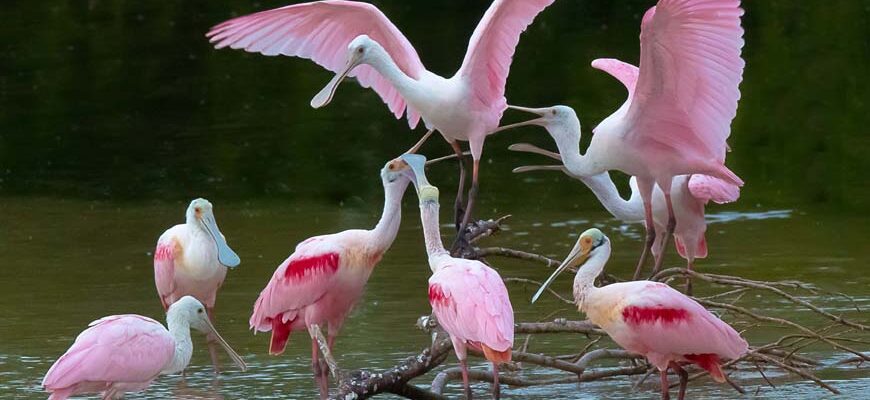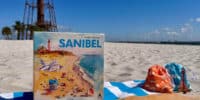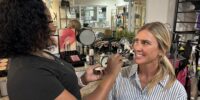Birds to Spot on Sanibel
Everyone knows that Sanibel Island is one of the greatest places to find shells. But did you also know that the island is home to a variety of bird species? Below, you’ll find J. N. “Ding” Darling Wildlife Refuge’s list of the top birds to keep an eye out for during your next visit to Sanibel Island.
Note: While all of these birds can be found enjoying the refuge of Ding Darling, several of these birds can be commonly found right on Sundial Beach Resort & Spa’s beaches! Keep an eye out for the Willet, Reddish Egret, Black-bellied Plover and Anhinga during your next visit.
1. Roseate Spoonbill: Platalea ajaja (photo, header, Liz Noffsinger)
Although Roseate Spoonbills are commonly mistaken for Flamingos, these distinctive pink birds are always causing a smile or burst of excitement from onlookers along Wildlife Drive. This gem of Sanibel is a medium to large-sized wading bird that can often be seen swinging its head back and forth as it forages for crustaceans, aquatic insects and small fish in shallow waters. Besides its obvious pink feathers, its second-most distinctive characteristic is within its name. These birds have long, flat and unusual spoon-like bills that make them stand out from every other bird on the Refuge.
Fun Fact: Roseate Spoonbills tend to resemble grandfathers as they get older. Much like our favorite relatives, spoonbills lose the feathers on the tops of their heads, experiencing their own form of “balding.”

2. American White Pelican: Pelicans erythrorhynchos (photo Wayne Kliewer)
If you’re looking for the largest bird on the Refuge, look no further – the American White Pelican will be sure to impress. This bird is almost twice as large as its feathered cousin, the Brown Pelican, and has a wingspan of 9 feet. You can sometimes see the pelicans working together and herding fish into shallow water for easy feeding. (They do not dive for fish like Brown Pelicans.) During breeding season, both sexes grow a prominent bump or “horn” on the tops of their beaks. The exact reason for this growth is not known, but is hypothesized to symbolize a more genetically “attractive” mate. Most of the White Pelicans that winter down on Sanibel migrate from Canada, Minnesota or other Northern states.
Fun Fact: Due to the American White Pelican’s size, it is very susceptible to overheating. To shed heat, they will face away from the sun and flutter their bill pouch. Their pouches contain lots of blood vessels that allow for the heat to escape.
3. Willet: Tringa semipalmata (photo Paul Smith)
Shorebird identification may be the most intimidating form of birding. Without the help of breeding plumage, a lot of our Floridian shorebirds look quite similar, almost all with characteristically brown and small. The Willet, fortunately, is much easier to recognize. With distinctive white and black wing markings and a call you will not forget, this frequent resident at the Refuge allows you to seem like a shorebird expert, even when that may be far from true. Willets are also much larger than a lot of their shorebird counterparts, growing to about the size of a pigeon. Their sensitive bill tip makes them good foragers for worms, snails, and sand crabs, and allows for them to hunt at night.
Fun Fact: Much like a Killdeer (another shorebird), Willets will pretend to be injured with a broken wing to turn a predator’s attention to them rather than their chicks or eggs.
4. Reddish Egret: Egretta rufescens (photo Kent Jager)
Reddish Egrets are the dancers of the birding world. Often seen in the waters off Wildlife Drive making rapid and random movements, the Reddish Egret is actually displaying its delicate grace while hunting. Raising its wings creates shadows in the water that fish correlate with safety and protection, thinking they are under a tree. That’s when the Reddish Egret strikes and stabs at its fish prey. This medium to large-sized heron comes in two color morphs; white and red. Reddish Egrets were almost wiped to extinction due to the plume trade in the late 1800s. Many egrets and herons were killed to obtain their beautiful feathers to place on women’s hats. Thankfully, due to federal protections, their numbers have increased.
Fun Fact: The “Ding” Darling Wildlife Society funds the satellite tracking of five Reddish Egrets between the Refuge and Bunche Beach. If you look closely at the Reddish Egrets along Wildlife Drive, you may be lucky enough to see one of these individuals with an antenna on its back.
5. Mangrove Cuckoo: Coccyzus minor
The Mangrove Cuckoo is the most elusive bird on the Refuge. This bird is rarely seen, and not a whole lot is known about it. Identification is fairly easy, thanks to its long, slender body and stout yellow and black bill. With funding from the “Ding” Darling Wildlife Society, a total of four birds are being satellite tracked on the Refuge. The goals of the research team are to find out if these birds are migratory and to learn more about the life history of the bird including breeding and nesting behaviors.
Fun Fact: The photo above won 2nd place in our 2017 Amateur Nature Photography Contest. It shows a Mangrove Cuckoo eating an iO moth caterpillar.
6. Black-bellied Plover: Pluvialis squatarola (photo Libby Erickson)
The Black-bellied Plover is the largest plover in North America. The breeding plumage of the male is unmistakable as its entire chest and most of its face is black. The female also displays black feathers, but they are less noticeable. This plover moves stop-run-stop or stop-run-peck looking for prey along the beach and during low-tide along Wildlife Drive.
Fun Fact: This plover breeds in high arctic zones on the tip of Canada.
7. Anhinga: Anhinga anhinga (photo Theresa Baldwin)
Nicknamed the “snake-bird,” the Anhinga has a long, slender neck that resembles a serpent as it swims through the water. It is able to dive and swim due to its reduced buoyancy caused by wet feathers and dense bones. Using its sharp bill, it spears fish in and out of the water. Commonly confused with a Double-crested Cormorant, an Anhinga has a dagger-like bill, rather than hooked, and is much slenderer than its doppelganger. Adult females and males display sexual dimorphism (distinct differences in appearances between sexes) with the male being completely black with white streaks on its back and wings, and the females having a pale colored head, neck, and chest. Anhingas are commonly seen drying off after an intense dive on the limbs of trees, logs, and rocks with their wings outstretched. They often resemble some kind of prehistoric aerial species.
Fun Fact: The male Anhinga starts constructing a nest before he has even found a mate. Once he has found a mate, the female finishes the nest.
Make sure to visit the Refuge’s free Education Center to learn more, then bike, hike or drive Wildlife Drive to make your own discoveries.










